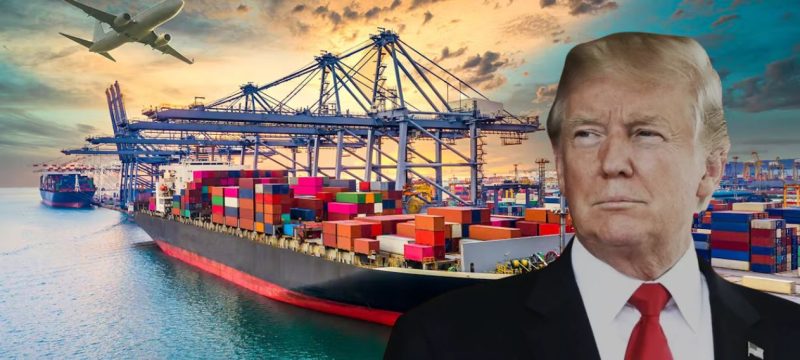The latest wave of U.S. trade tariffs, announced on Wednesday, is expected to further weaken a global economy still struggling to recover from post-pandemic inflation. With record-high debt and ongoing geopolitical tensions, economic uncertainty continues to mount.
The impact of these tariffs, and how President Donald Trump and other world leaders respond, could mark a major shift in the global economic system—one that has long relied on the U.S. as a pillar of stability.
Read more: Anduril Sees Positive Relations with Trump Administration for AI Defense Tech
Takahide Kiuchi, executive economist at Nomura Research Institute, warned that “Trump’s tariffs threaten to dismantle the global free trade order that the U.S. has championed since World War II.”
In the short term, however, the most immediate effects will be rising costs for goods and services, reducing consumer demand worldwide. Antonio Fatas, a macroeconomist at INSEAD business school, cautioned that these tariffs could lead to declining economic performance, heightened uncertainty, and even a global recession.
Speaking from the White House Rose Garden, Trump announced a 10% baseline tariff on all imports and displayed a chart showing significantly higher duties on key trading partners—34% on China and 20% on the European Union. A 25% tariff on automobiles and auto parts had already been confirmed. Trump argued that these measures would help restore critical manufacturing industries to the U.S.
With the new tariffs in place, the average U.S. import tax has surged to 22%, a level not seen since 1910, compared to just 2.5% in 2024, according to Olu Sonola, head of U.S. economic research at Fitch Ratings. He described the move as a “game changer” that could push multiple countries into a recession.
IMF Managing Director Kristalina Georgieva, however, stated in a recent Reuters event that while a global recession is not yet imminent, the IMF expects to slightly lower its 2025 global growth forecast of 3.3%.
Uneven Economic Impact Across Nations
The effect of Trump’s tariffs will vary across different economies. The U.S. has set different tariff rates for various countries, ranging from 10% for the UK to 49% for Cambodia. If other nations retaliate with their own tariffs, the consequences could be severe, particularly for manufacturing powerhouses like China, which would be forced to seek alternative markets amid sluggish domestic demand.
“Asian economies will bear the brunt of these tariffs,” said Marcel Thieliant, head of Asia-Pacific at Capital Economics. “Not only do they face higher U.S. tariffs, but they also rely heavily on American demand for their exports.”
If the U.S. economy itself slips into recession, the fallout could be especially severe for developing nations that depend on American economic stability.
Stock markets plunged on Thursday as investors, worried about the economic impact, shifted their funds into safer assets such as bonds, gold, and the Japanese yen.
Challenges for Central Banks and Governments
The new tariffs could disrupt global supply chains that have kept consumer prices low for years, potentially leading to persistently high inflation. This would complicate monetary policy for central banks worldwide, which have been trying to stabilize inflation around 2%.
Japan, which faces a 24% tariff on auto exports to the U.S., may need to hike interest rates just as other major economies consider cuts. Meanwhile, South Korea, subjected to a 25% tariff, has announced emergency measures to support its affected businesses.
Despite being longstanding U.S. allies, Japan and South Korea were among the nations Trump accused of engaging in unfair trade practices. Japan’s trade minister warned that the tariffs might violate World Trade Organization (WTO) rules but only stated that Tokyo would “explore various options” in response.
Australian Prime Minister also criticized the tariffs as an unfriendly act but ruled out imposing retaliatory measures.
Weaker economic growth may also make it harder for governments to manage the world’s record-high $318 trillion debt, leaving them with fewer resources to allocate to defense, climate initiatives, and social welfare programs.
A Shift in U.S. Trade Strategy
Trump’s main objective is to boost domestic investment in American manufacturing. However, with labor shortages and an already tight job market, it remains uncertain whether businesses will follow through with major investments.
Some analysts predict that if tariffs fail to eliminate the U.S. trade deficit—a long-standing concern for Trump—he may push for currency interventions, urging other nations to adjust exchange rates in favor of American exports.
“We could see Trump resorting to more aggressive and unpredictable measures to counterbalance the strong U.S. dollar,” said Freya Beamish, chief economist at TS Lombard.
Such actions could threaten the dollar’s status as the world’s primary reserve currency, though few see a viable alternative at this time.
European Central Bank President Christine Lagarde, speaking in Ireland, emphasized the urgency of reforming Europe’s economy in response to an increasingly fragmented global order.
“In the past, we all benefited from a dominant U.S. committed to a multilateral, rules-based system,” she said. “Today, we are facing a world of division, uncertainty, and economic realignment.”









